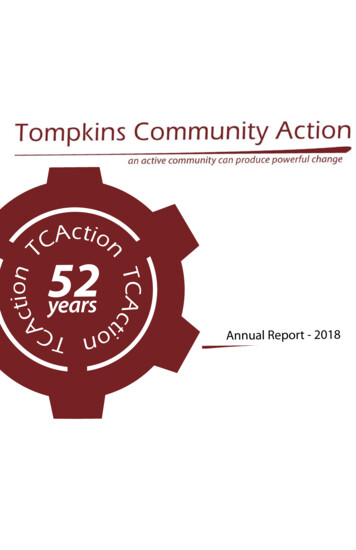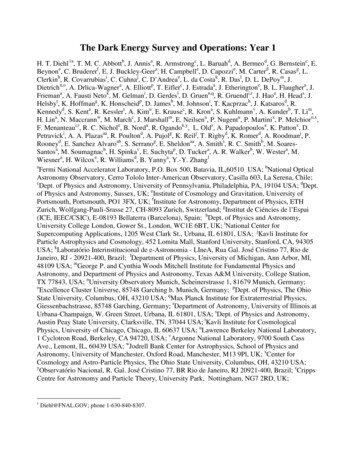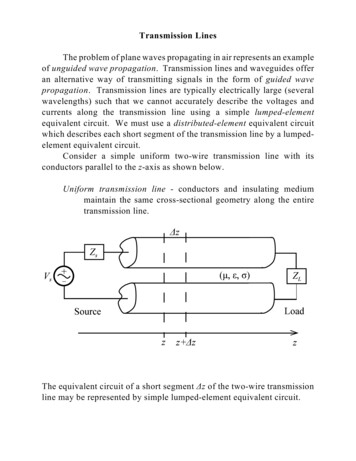
Transcription
ctioACTCActonitcTAn25yearsAnnual Report - 2018Tion C
What are Community Action Agencies?During President Lyndon Johnson’s 1964 State of the Union Address, he said “this administration, here andnow, declares unconditional war on poverty.” Through that declaration, Community Action Agencies werecreated and today there are more than 1100 agencies serving 99% of the counties in the Unated States.President Johnson and Congress envisioned a Great Society and the need to provide people with lowincomes not only resources but tools for achieving self–sufficiency. That vision became the mission ofCommunity Action Agencies and remains our mission today.EconomicOpportunityActImplementtheVisionIn 1964 the Economic Opportunity Act passed with a singular mandate — “to mobilize the human and economic resources of the Nationto combat poverty in the United States.” The Act defined our societal success “only if every individual has the opportunity to contributeto the full extent of [their] capacities and to participate in the workings of our society.” Community Action Agency goals were defined as“enabling low-income persons to achieve self-sufficiency; that poor people should be provided with opportunities where their efforts wouldfacilitate moving into the mainstream of American life.” For the first time legislation not only defined the need for economic resources;it mandated participatory training to ensure involvement by low-income people in voicing their vision of the future. By the end of 1966,Community Action Agencies were forming nationwide, in both urban and rural areas, answering the call to the unconditional war on poverty.The Office of Economic Opportunity was established in 1964 to implement the War on Poverty. Its first Director was Sargent Shriver. Hebelieved passionately that we could end poverty and spent his life championing that effort. He helped create the first programs for CommunityAction Agencies (CAA) that year: JobCorps, Youth Work Training and Vista. In 1965 Shriver spearheaded the creation and implementation ofHead Start. In its first year, it served 850,000 families in an eight week summer program. The Civil Rights Act of 1968 established a provisionfor Section 8 Housing Vouchers. That year CAA’s were awarded funds through the Department of Housing and Urban Development starting ahistory of CAA funding from multiple Federal agencies. In 1976 the Department of Energy established the Weatherization Assistance Programand CAA’s began to implement energy remediation that is today as essential to the well being of our residents as it was at its inception.Bridgeto theCommunityThe 1967 Amended Act further defined the purpose of CAA’s - “to stimulate a better focusing of all available local, state, private and federalresources upon the goal of enabling low income families and individuals of all ages, in rural and urban areas to attain skills, knowledge andmotivations to secure opportunities to be self sufficient.” Congress saw CAA’s as pivotal participants in coordinating community resources andoutreach. CAA’s would have the ability to blend multiple funding streams to provide comprehensive programs. CAA’s would act as a “bridge”between public funders, enlisting the private sector and those they sought to serve. Today TCAction works in partnership with TompkinsCounty organizations and institutions; leveraging resources, coordinating referrals, and actively participating in the community to reach lowincome residents.MeasuringOutcomesSince the first uttering of the War on Poverty there has been an on-going debate about both the measurement of poverty and programeffectiveness. Indeed, many agencies at the Federal level have varying thresholds defining poverty and in turn program participation.In 1981 Congress established the Community Service Block Grant (CSBG) to fund CAA’s nationwide. Although today these funds onlyrepresent approximately 10% of CAA budgets, the program serves to provide national unified reporting and measurement. The GovernmentAccounting Office monitors CSBG funds; and in 2000 they reported that CAA’s were effective community agents; reducing duplications andeffectively reaching those intended to benefit from the Economic Opportunity Act. In 2002 the Office of Community Services reported thatCAA’s were delivering comprehensive programs and services to approximately one fourth of all people living in poverty in the United States.
tion TAcTCAct52yearsnCActioTCAction program delivery is administered through three Departments: Family Services, Energy Services and HousingServices. Our service philosophy is based on the Family Development Model, which redirects the way health, educationand human services are delivered to families. This model moves systems away from crisis-oriented, fragmentedservices toward an empowerment, support-based approach to working with families. Family Development emphasizesstrength-based partnerships, mutual respect, interagency collaboration and family-centered services.Tion CsSTCAction Head Start and Early Head Start programs served 350 children and their families. Program services were provided to pregnant women, newborns and children up to fiveyears old, in classrooms and families’ homes. With 18 classrooms county-wide and 9 Ithaca City School District classroom collaborations, children and families received high quality,developmentally appropriate education individualized to enhance learning and access community resources in preparing our children for a lifetime of learning. Utilizing HighScope Curriculum, focused on five school readiness domains, this year’s child assessments reflected achievement across all domains. Children’s approaches tolearning increased by 38%; reflecting their abilities to problem solve, plan, and expand their initiative. Language and literacy skills increased by 39% and physicalmdevelopment skills scores increased by 33%. Social skills increased by 39%. Children’s math and science skills increased by 50%; these gains were enhancedFa amilySciencenter.localourwithutilizing the ECHOS science curriculum implemented through a collaborationAction Groups, training, secondary education opportunities and seminars throughout the year. Transition to Kindergarten included a variety of activities, sucheras panel discussions with school district personnel, principals speaking at Parent Action Groups, and visits to school cafeterias, libraries and gymnasiums. Ourv tionshipsstrengthentoofficialsPrimary School Support Program worked closely with parents and schoolAdvocates supported families at parent-teacher conferences, coordinated services for children with special needs and supported positive communicationbetween families and school staff. We served 95,109 breakfasts, lunches and snacks to children and families with expanded activities that linked LANA nutritioncurriculum to the home. Serving Up the Harvest activities provided families with extended nutrition education and opportunities to acquire cooking skills.Collaborating with Finger Lakes Community Health has provided for dental screenings and cleanings for children while reinforcing oral health care in the home through child andfamily education and supplies. Our Family Home Library provided 3,092 books and activities to family homes funded through the Park Foundation. U.S. Department of Health&Human program funding totaled 3,625,144. Of which 2,683,290 supported wages and fringe benefits, 575,223 for operations, 242,000 in contracted services and 63,051 forconsumables. An additional 51,580 of funding expanded staff and parent education and training.We provided Housing Choice Voucher Program rental assistance to 1149 households and paid out 8,847,707.00 in rental subsidy to landlords. Twohundred and six households participated in the Family Self Sufficiency Program (FSS), of which 68 FSS participants developed savings accounts as aresult of an increase in earned income. One household purchased their first home as part of our Homeownership Program and used their FSS escrowfunds for a down payment. As a partner of the Solutions to End Homelessness Program of Tompkins County, TCAction provided financial assistanceand supportive services to 29 households to assist them to stabilize their housing and prevent eviction. We also assisted 21 households experiencinghomelessness to secure and stabilize in rental housing through the Tenant Based Rental Assistance Program. Our Supportive Housing for FamiliesProgram provided permanent supportive housing to 6 young, pregnant or parenting families experiencing homelessness with safe and stable affordablehousing at the Corn Street Apartments. Chartwell House provided affordable and safe permanent supportive housing for 17previously homeless men in substance dependence recovery. Magnolia House provided affordable and safe permanent supportivehousing for 17 women, and a child if appropriate, in recovery who were experiencing homelessness prior to move in. Our AmiciHouse Supportive Housing Program opened in February 2019 and provides supportive services to 26 young adults and 9 youngchildren experiencing homelessness prior to move in. In all TCAction Supportive Housing Programs’ service delivery focuses onsupporting residents with Early Head Family Services Start/Head Start programming, building life and housing stability skills, securing and maintainingemployment, and furthering education goals. Our Building Performance Institute certified energy technicians performed energy audits, efficiency upgradesand resident education to save energy for little or no money. This year, 35 households with low incomes benefited from our Weatherization AssistanceProgram. Thirty-two households made energy improvements through Assisted Home Performance with Energy Star, Green Jobs-Green New York and/orBuilding Energy Services fee for service program options. Thirty-one households with low-incomes received electricity reduction measures through TCAction’sEmpower NY at no cost.The National Community Action Foundation (NCAF) was founded in 1981 with the purpose of representing CAAs and their state andregional associations in Washington, D.C. Current Executive Director David Bradley, with the mentorship of Sargent Shriver, co-foundedthe organization in an effort to ensure that the federal government continued to support the Community Action Program.The New York State Community Action Association (NYSCAA) was created in 1987 to provide New York State Community Action Agencieswith information, professional development, and technical assistance to enhance the capacity of agencies to serve as effective,responsive community resources. New York State has 49 Community Action Agencies, all of which are NYSCAA members. Additionally,NYSCAA serves the collective interests of its members through statewide legislative advocacy, information exchange, capacity-building,peer support, recognition and information technology servicesTCAction’sHistoryGovernanceTompkins Community Action is a private, not for profit charitable organization that had its grassroots beginning in 1964. Originally, TompkinsCounty Economic Opportunity Corporation, or EOC, as it was known until our official corporate name change to Tompkins Community Action in1999, began as a local coalition of concerned community members who wanted to improve the lives of low income families in Tompkins County.Formally incorporated in 1966, the Agency became part of a National and State network of Community Action Agencies. Growing from a smallnot-for-profit with a budget of 25,000 and a staff of 3.5 employees in 1966, EOC transformed and grew into Tompkins Community Action, a large,multi-faceted community action agency implementing and integrating 19 programs that serve low-income individuals, families and communitycollaborations. As one of Tompkins County’s larger employers, the agency currently has a staff of 104 people who annually assist approximately6,000 individuals with low incomes through our programs. We entered this year with renewed commitment to our mission, vision, and strategiesfor ending cycles of poverty in Tompkins County.The Economic Opportunity Act defined CAA Boards to include all community members and mandated that boards of directors be tripartite incomposition: one third each of public officials, private sector and low-income representatives. At the time, it was considered a “communityrevolution” to mandate representation by all community stakeholders. This mandate provided the structure for low-income voices to form theirvision of their future. Board members are volunteers and nationally over 20,000 CAA board members ensure local control of agency initiatives,finances and community involvement. Additionally, in 1995, TCAction established an Advisory Board to facilitate the development of initiatives andprovide operational expertise. When Head Start program guidelines were defined in 1965, they included the formation of a Policy Council, againensuring that low-income participants were provided with opportunities to voice their vision. Policy Council is comprised of past and current HeadStart parents and community members who have an interest or expertise in early childhood education and family development. Policy Council andthe TCAction Board of Ditectors have liaisons to each other ensuring communication, coordinated efforts and shared expertise.Revenues and Expenditures 2018
Tompkins Community Action:Serving Tompkins CountyLANSINGGROTONU LY S S E SDRYDENENFIELDITHACACAROLINEDANBYNEWFIELDTCAction HeadquartersHead Start sitesSupportive Housing sitesHome Ownership participantsIndividual households servedHousehold locations have been moved by small amounts to protect the privacy of our consumers.CarolineDanbyDrydenEnfieldGrotonEnergy Services:16 householdsHousing Choice Voucher Program:40 householdsFamily Self-Sufficiency:5 householdsFood Pantry:87 visitsHead Start / Early Head Start:3 children and their familiesPrimary School Support:1 child and their familyHome Ownership:1 householdEnergy Services:12 householdsHousing Choice Voucher Program:19 householdsFamily Self-Sufficiency:3 householdsFood Pantry:59 visitsHead Start / Early Head Start:3 children and their familiesPrimary School Support:1 child and their familyEnergy Services:94 householdsHousing Choice Voucher Program:197 householdsFamily Self-Sufficiency:6 householdsFood Pantry:469 visitsHead Start / Early Head Start:57 children and their familiesPrimary School Support:37 children and their familiesHome Ownership:2 householdsEnergy Services:28 householdsHousing Choice Voucher Program:74 householdsFamily Self-Sufficiency:3 householdsFood Pantry:180 visitsHead Start / Early Head Start:17 children and their familiesPrimary School Support:7 children and their familiesOwnership:Home Ownership1 householdEnergy Services:21 householdsHousing Choice Voucher Program:43 householdsFood Pantry:47 visitsHead Start / Early Head Start:33 children and their familiesPrimary School Support:11 children and their familiesHome Ownership:3 householdsIthaca (town and city) LansingEnergy Services:68 householdsHousing Choice Voucher Program:507 householdsFamily Self-Sufficiency:55 householdsFood Pantry:695 visitsHead Start / Early Head Start:117 children and their familiesPrimary School Support:9 children and their familiesHome Ownership:5 householdsSupportive Housing:33 householdsEnergy Services:19 householdsHousing Choice Voucher Program:47 householdsFamily Self-Sufficiency:5 householdsFood Pantry:149 visitsHead Start / Early Head Start:16 children and their familiesPrimary School Support:10 children and their familiesOwnership:Home Ownership1 householdNewfieldUlyssesEnergy Services:59 householdsHousing Choice Voucher Program:102 householdsFamily Self-Sufficiency:5 householdsFood Pantry:276 visitsHead Start / Early Head Start:8 children and their familiesPrimary School Support:2 children and their familiesHome Ownership:2 householdsSupportive Housing:2 householdsEnergy Services:27 householdsHousing Choice Voucher Program:37 householdsFood Pantry:96 visitsHead Start / Early Head Start:24 children and their familiesPrimary School Support:9 children and their familiesHome Ownership:1 household12 households were served in adjoining countiesthrough the Nursing Home Transition DiversionMedicaid Waiver Program.
Advocacy Center Alcohol and Drug Council Alternatives Federal Credit Union Area Congregations Together B & W Restaurant Supply BorgWarner Morse TEC Buttermilk Falls Pediatrics CAPLAW Cargill Catholic Charities Cayuga Addiction Recovery Services Child and Adult Care FoodProgram Child Development Council Children’s Reading Connection City of Ithaca Clarks Shur Fine Foods Collaborative Solution Network Collective Impact Initiatives Community Action Partnership Community Dispute Resolution Center Community Foundation of Tompkins County Cornell Cooperative Extension Tompkins County Cornell University Corporation of National Community Service Cortland State University DrydenCentral School District Family and Children’s Services Finger Lakes Community Health Finger Lakes Independence Center Finger Lakes ReUse Food Bank of the Southern Tier Food Distribution Network Franziska Racker Centers Get Your Green Back Groton Business Association GrotonCentral School District Groton National Bank Groton Nursing Facility Groton Public Library Habitat for Humanity Tompkins and Cortland HomeDepot Homeless and Housing Task Force Human Services Coalition of Tompkins County Ithaca City School District Ithaca College School of Speech,Language and Pathology Ithaca Housing Authority Ithaca Neighborhood Housing Services Ithaca Pregnancy Center Ithaca Urban Renewal Agency Ithaca Youth Bureau Ithaca/Tompkins Continuum of Care J.B. Smith Landlord Association of Tompkins County Lansing Central School District LawNY Learning Web Lion’s Club of Ithaca Longview Lowes Manufacturers and Traders Bank Manufacturers and Traders Bank Foundation MentalHealth Association of Tompkins County MOMS/Medicaid Obstetrical and Maternal Services Municipal Drug Policy Committee National Associationfor the Education of Young Children National Community Action Foundation National Head Start Association Natural Leaders Initiative NewfieldCentral School District Northeast Pediatrics NYS Community Action Association NYS Council of Non-Profits NYS Department of Health, HPNAP NYSDepartment of State, Division of Community Services NYS Head Start Association NYS Homes and Community Renewal NYS Office of Children andFamily Services NYS Office of Temporary and Disability Assistance NYS Weatherization Directors Association NYSERDA Opportunities, Alternativeand Resources Park Foundation Planned Parenthood of Tompkins County Rural Housing Coalition Schickel Architecture Schickel Construction Sciencenter Second Wind Cottages SewGreen Soldier On Southern Tier Aids Program Southern Tier Independence Center SPCA Tompkins County Supportive Housing Network of NYS Sustainable Tompkins St. John’s Community Services Syracuse University T. G. Miller Taitem Engineering Tompkins Cortland Community College Tompkins County Health Department Tompkins County Administration Tompkins County Climate ProtectionInitiative Tompkins County Department of Social Services Tompkins County Drug Court Tompkins County Early Intervention Tompkins CountyFamily Treatment Court Tompkins County Mental Health Department Tompkins County Office for Aging Tompkins County Planning Dept TompkinsCounty Probation Tompkins County Public Library Tompkins County Solid Waste Tompkins County Youth Services Tompkins Seneca Tioga BOCES Tompkins Trust Company Tompkins Workforce Ultimate Reentry Opportunity Unitarian Church United Way of Tompkins County US Department ofAgriculture US Department of Energy US Department of Health and Human Services US Department of Housing and Urban Development US Officeof Community Services Village at Ithaca Village of Dryden Village of Groton Wal-Mart Wegmans Welliver Wilson Dental Wipfli Women, Infantsand Children Women’s Opportunity Center Workforce Investment Board onitcTATCAct52yearsnctiAoCTion Can active community can produce powerful changeThank You
Primary School Support: 10 children and their fa m i l i e s Home Ownership: 1 household Newfield Energy Services: 59 households Housing Choice Voucher Program: 102 households Family Self-Sufficiency: 5 households Food Pantry: 276 visit s Head Start / Primary School Support:Early Head Start: 8 children and their families Primary School Support:

